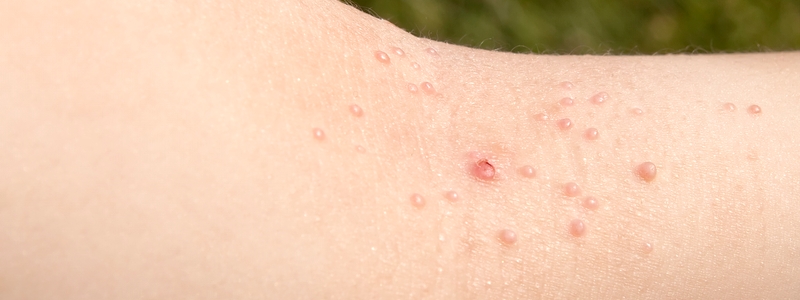

Laser treatments can be an ideal alternative for treating hyperpigmentation in addition to sun damage and fine lines. There are quite a few laser treatments on the market, but we're here to share information about Erbium laser resurfacing, a treatment that does it all and treats everything from wrinkles, acne scars to sun damage and brown spots/age spots. While this treatment provides a more youthful appearance it usually requires a week of down time.
Erbium laser resurfacing uses light energy and is designed to remove the upper most superficial layers. Removing brown spots and benign and precancerous bumps/growths. The Erbium laser results in a narrower area of heating of adjacent tissues compared with other laser skin-resurfacing methods. This results in a more focused removal of old skin cell layers. And this means that a benefit of Erbium laser resurfacing is minimal burning of surrounding tissue and fewer side effects such as swelling, bruising, and redness, so the recovery time should be faster than with CO2 laser resurfacing. During the healing process new collagen is generated for a more youthful appearance.
Helps reverse sun damage
Treats fine lines, wrinkles, and hyperpigmentation
Requires no downtime
Can be safer for lighter-toned Black, Hispanic, or Asian skin tones, Erbium laser resurfacing can sometimes be a good option. Patients with darker brown skin may need to consider other skin resurfacing options, such as radio-frequency treatments.
With the use of a potent topical anesthetic the Erbium laser treatment is well tolerated. Usually up to the first hour after treatment it feels like a bad sunburn. After which it may feel sore and have some bruising and mild swelling for a few days. Followed by a few days of skin flaking for another two to three days. Usually, the total recovery/healing on average takes about 10-14 days, depending on the problem and area that was treated.
Despite the downtime, the benefits are that you require fewer laser treatments to obtain your goal of smoother, younger looking skin.
If you're ready to treat skin concerns that your skincare routine cannot address, talk with Dr. Bruce Robinson about Erbium laser resurfacing.
Electrodessication can eliminate small growths without your friends knowing you had anything done. The rapid healing time and excellent cosmetic results make this a favorite treatment for our patients.
Do you dislike those brown wart like bumps around you eyes, face or breasts? Or the fleshy bumps on your neck? Electrodessication is an easy treatment with no down time that can eliminate these bumps usually in one treatment.
Electrodessication works by simply taking heat to melt these bumps within seconds.
Most patients do not need any anesthesia. For more sensitive patients we apply a topical anesthetic for 20 to 30 minutes before the treatment to eliminate most if not all discomfort.
Torn, split or long and droopy earlobe rejuvenation is an easy in-office procedure that takes approximately 30 minutes from start to finish. Under local anesthesia an enlarged earring hole is closed or a torn earlobe is restored. The sutures are removed in just one week. Dr. Robinson can re-pierce your ears 6 weeks later (https://brucerobinsonmd.com/earlobe-piercing/). So go ahead and get those earrings you always wanted but couldn't wear.
Yes! While a torn earlobe can be painful and distressing, an expert dermatologist like Dr. Bruce Robinson can effectively repair it with just a few precise sutures. Using advanced cosmetic surgical techniques, Dr. Robinson ensures a clean repair that typically heals into a small, barely noticeable scar. About three months after the procedure, patients can return for professional re-piercing. Dr. Robinson carefully places the new piercing at a safe distance from the repaired area to prevent any further damage.
The first step in repairing a torn earlobe is a consultation with experienced, board-certified dermatologist Dr. Bruce Robinson. He will thoroughly evaluate the damage and determine if you’re a good candidate for earlobe repair. Listening closely to your cosmetic goals, Dr. Robinson will develop a personalized treatment plan tailored to your needs.
The procedure is performed safely in-office without sedation or general anesthesia. Dr. Robinson will numb the earlobe with local anesthesia to ensure your comfort throughout the treatment. He will then carefully remove any scar tissue around the tear and expertly suture the wound closed. The exact technique used depends on the severity of the tear, whether it’s a minor split or a complete rupture. For patients with sagging earlobes, Dr. Robinson may also use hyaluronic acid fillers like Juvederm or Restylane to restore volume and lift.
After the procedure, Dr. Robinson will provide detailed post-care instructions. Most patients only need over-the-counter pain relief, such as Tylenol, if any discomfort arises. Sutures are typically removed two weeks post-treatment, and approximately three months later, patients can return for safe and precise earlobe re-piercing. Dr. Robinson ensures the new piercings are symmetrical and positioned to avoid further damage to the repaired area.
Sagging or stretched earlobes can result from various factors. Tears or injuries, frequent wearing of heavy earrings, and even sleeping with earrings can stretch the delicate skin, causing earlobes to sag over time. Additionally, natural aging reduces collagen and elastin production, proteins essential for skin firmness and elasticity leading to loss of volume and drooping earlobes.
Dr. Robinson offers a non-surgical solution to restore lost volume and firmness using dermal fillers like Restylane and Juvederm. These fillers contain hyaluronic acid, a naturally occurring substance that enhances skin hydration and volume. Injecting these fillers into the earlobes improves elasticity and helps support earrings comfortably.
The earlobe filler treatment is quick, simple, and minimally uncomfortable. A topical numbing cream is applied about an hour before your appointment to reduce any discomfort. Once in the office, the area is cleaned and sterilized before Dr. Robinson expertly injects the chosen filler to rejuvenate your earlobes. After the procedure, ice is applied to minimize swelling or bruising.
Mild redness, swelling, or bruising may occur but typically resolve within a few days. To reduce bruising, patients prone to it can take oral Arnica supplements before and after treatment. It’s also recommended to avoid blood thinners such as NSAIDs, fish oil, and vitamin E for one week before and after the procedure.
Dermal fillers provide a safe and effective, non-invasive way to restore volume and durability to sagging earlobes. Results usually last about six months, depending on the filler used.
Schedule an office visit to discuss your concerns and skincare goals with Dr. Robinson and the office visit cost will be applied to the future cost for the "consulted procedure". The "consulted procedure" must be completed within 30 days of your consult visit.
The Coren PS earpiercer painlessly pierces your earlobes and inserts a sterile, hypoallergenic, 24k gold ear stud.
You laugh, you frown, you concentrate... and over time, those expressions leave their mark upon you face. No one is immune to wrinkles. Just squinting in the bright sunlight or concentrating at a board meeting can create facial lines over time. Reveal a younger looking you by erasing fine lines and wrinkles while maintaining your ability to make natural facial expressions.
Dysport, a muscle relaxer, targets "expression" lines and wrinkles. Over time “dynamic wrinkles” created by muscle movement leave their mark on your face. Dysport injections temporarily relax the facial muscles that contribute to wrinkles every time they contract.
Dysport uses:
One ten-minute treatment – a few tiny injections – relaxes the muscles in your face that cause lines to form. There is minimal discomfort, many patients describe the injections as a pinprick or bug-bite sensation.
Within two weeks of treatment, targeted wrinkles begin to fade leaving skin looking more smooth and youthful. Improvements usually last between 3 to 6 months and can often be maintained with periodic touch-up treatments.
These quick, simple injections can effectively improve your facial wrinkles while maintaining your ability to make natural facial expressions, an essential part of what keeps you looking like you!
Men and women alike share a common desire to have healthy, youthful skin. Exposure to the sun and the elements in combination with adverse living habits contribute to the appearance of our skin. Chemical Peels are increasingly popular with those who are unhappy about acne scarring, sun-damaged skin, age spots, freckles, fine lines, rough skin and uneven pigmentation. A chemical peel is not limited to the face, and can be performed on the neck, chest, hands, arms, shoulders and leg with little or no downtime.
"All my life I had freckles on my face. Having a Chemical Peel changed that! Now my skin is smooth and clear!"
Chemical Peels are topically applied acids that aid in the restoration and rejuvenation of the skin's surface. They usually create an invisible uniform and controlled shedding of several layers of the skin. Depending on the nature and depth of the peel, a significant number of layers can be exfoliated allowing new growth to be exposed, creating a fresh vibrant appearance.
Your skin type and the results you are aspiring to achieve will determine if you are a candidate, as well as which class of peel is most appropriate for you.
Chemical peels can enhance your appearance by reducing blotchy and uneven pigmentation, fine lines and wrinkles, freckling, age spots, sun-damaged skin, and acne scars in a relatively brief measure of time. Chemical peels accelerate the production of new cells. Enjoy fresh smooth skin immediately after your first treatment.
Chemical peels have become increasingly popular because of the array of advantages and relative lack of complications, Side effects are rare and usually temporary. Some side effects include uneven pigmentation, redness, and very infrequent scarring if the skin is not cared for appropriately. Sun protection is crucial to minimize the risk of side effects. A treatment program of individually suited products and sun protection will benefit your skin's ability to maintain the results of the peel. You can decrease the likelihood of side effects by carefully following your post peel instructions.
Chemical peels are classified as superficial, medium, and deep peels.
This peel is designed to help smoothen coarse, dry skin, improve the texture of sun-damaged skin, and even out skin tone. The recovery is generally rapid and usually involves some minor flaking. A series of treatments is ordinarily recommended to obtain the desired result over a period of time. Typically, there is no down time and with appropriate sun protection, you can resume regular activities immediately.
Medium peels contain a stronger potency of acids. Medium peels target the epidermis and upper dermis and cause the skin to slough within 5 - 7 days. Immediately after treatment the skin has a red appearance and is occasionally accompanied by swelling. Within a day the skin turns brown in color and after 3 or 4 days the skin initiates the peeling process.
Deep peels produce the most dramatic results. This peel is recommended for treating wrinkles, scars, blemishes and, in some cases, precancerous skin lesions. A deep peel targets the dermis. In some cases, anesthesia is required during the procedure to reduce the warm to hot stinging sensation. After a deep peel, the skin is red and can result in some swelling and blistering. A crust may form and the skin will turn brown just prior to peeling. Many layers of the skin will peel over a period of one to two weeks. An ointment may be given to keep the area moist. Temporarily, the new skin will have the color and sensation of significant sunburn, which will gradually fade to your normal skin color.
Canthrone is an excellent treatment for warts, molluscum and other growths in the skin. It is painless and therefore preferred by many of our pediatric patients and adults who are adverse to even a little discomfort. It is usually applied with a Q-tip (for children we refer to it as a tickle stick) and then covered with paper tape or a bandaid. Patients are instructed to wash it off between twenty minutes to one hour later. Although several treatments may be required, Canthrone is the kindler and gentler treatment for these ailments.
As the United States declares Monkeypox outbreak a public health emergency, NYC declares a local state of emergency due to the outbreak. The American Academy of Dermatology & The World Health Organization have put together a Task Force to address the growing outbreak of Monkeypox (orthopoxvirus) in the US. Monkeypox is a contagious disease caused by the Monkeypox virus. US Map and case count on the 2020 outbreak here ...
Anyone can get Monkeypox. It is primarily spread through close, physical contact between people. In the current outbreak, the Monkeypox virus is spreading mainly during oral, anal and vaginal sex and other intimate contact, such as rimming, hugging, kissing, biting, cuddling and massage.
Previous outbreak experience elsewhere suggests that the elderly, those with weakened immune systems, pregnant people, and children under 8 years of age may be at heightened risk for severe outcomes. Smallpox vaccine may help protect you against Monkeypox. Although, immunity may wain with age, it is estimated that the smallpox vaccine can be over 80% effective in preventing Monkeypox. Howevver, the vaccine for smallpox was discontinued in 1972 when it was eradicated in the United States. So therefore, anyone who is 49 years of age or younger most likely did not receive a smallpox vaccine.
The best way to protect yourself from Monkeypox is to avoid sex and other intimate contact with multiple or anonymous partners.
If you choose to have sex or other intimate contact, the following can help reduce your risk:
How to Protect Yourself and Others from Monkeypox (PDF)
Most cases are mild. Symptoms usually start within two weeks of exposure, but in some cases they may not appear for up to 21 days. If you have a new, unexplained skin rash or lesion(s)/bump(s) on your skin and you don’t know what caused it and think you may have Monkeypox, it is important to see your dermatologist quickly to prevent exposing more people. Eligible New Yorkers who may have been exposed to Monkeypox can now get vaccinated to stay safe and slow the spread.
Some symptoms include:
A person is contagious until all sores have healed and a new layer of skin has formed, which can take two to four weeks.
If you start experiencing symptoms, isolate at home immediately, ideally stay in a separate area away from other family members and pets and talk to your dermatologist.
The following may increase your risk for severe disease if you are infected: HIV; other conditions that weaken your immune system; and a history of atopic dermatitis or eczema. If you have one of these conditions, it is especially important to see a provider right away, if you have symptoms.
To protect others while you are sick:
Not every rash is Monkeypox. Dr. Robinson can make a diagnosis of Monkeypox by looking at the pattern on the skin and where the rash appears. Please let the office know ahead of your visit that you have a "new unexplained rash or lesions" and think you may have monkeypox. If Dr. Robinson suspects Monkeypox may be the cause of the rash, he will swab the rash and send it to a lab, where a polymerase chain reaction test will be performed.
There is treatment approved for Monkeypox. Most people get better on their own without treatment. However, antiviral medication(s) (TPOXX) may help. Your provider will help you find out if you are eligible for antiviral treatment. They may be able to prescribe medicine and provide information about symptom relief.
Vaccination after possible exposure ... Eligible New Yorkers who may have been recently exposed to Monkeypox can get the JYNNEOS TM vaccine. Vaccine is free and available regardless of immigration status. Information about eligibility for the vaccine and appointments can be found here.
Getting vaccinated after a recent exposure may reduce the chance of you getting Monkeypox and it can reduce the symptoms if you do get it.
People should get two doses, at least four weeks apart.
Information about eligibility for the vaccine clinic and appointments can be found here.
JYNNEOS Vaccine for Monkeypox: Frequently Asked Questions (PDF)
Additionally, here is a link to a letter published in the Journal of the American Academy of Dermatology (JAAD) that explains the symptoms and features of monkeypox. For more information about monkeypox, visit the AAD website.

Molluscum Contagiosum rarely causes pain and will eventually clear on its own if you have a healthy immune system. They may go away without a trace, but this takes time, during which they can spread. On average, the bumps clear in 6-18 months without treatment. Sometimes, this takes longer and they can re-occur.
Avoid spreading molluscum to other parts of your body by:
Until the molluscum bumps go away, take precautions to help prevent spreading the molluscum virus to others. Watch what the American Academy of Dermatology recommends here ... https://youtu.be/klkQ2YcJHaw
Dr. Robinson also recommends:
Dr. Robinson offers these tips and others every day to help his patients feel more comfortable in their own skin.
The best way to protect infants from the sun is to keep them in the shade as much as possible, in addition to dressing them in loose fitting long sleeves, pants, a wide-brimmed hat that shields the face, ears, back of the neck and sunglasses with at least 99% UVA/UVB protection. If you can’t find shade, create your own using an umbrella, canopy, or the hood of a stroller. Make sure they do not get overheated and that they drink plenty of fluids. If your baby is fussy, crying excessively, or has redness on any exposed skin, take him or her indoors.
Minimize sunscreen use on children younger than six months old. However, if shade and adequate clothing are not available, The American Academy of Dermatology (AAD) recommends that all kids — regardless of their skin tone — wear sunscreen with an SPF of 30 or higher that is broad-spectrum and water resistant.
For babies older than 6 months, when outdoors, sunscreen should be applied to all areas of the body, but be careful around the eyes. If your baby rubs sunscreen into their eyes, wipe their eyes and hands clean with a damp cloth. Reapply sunscreen every two hours or immediately after getting out of the water. Sunscreens that use zinc oxide may cause less irritation and/or allergic reactions to their sensitive skin. If a rash develops please call our office.
Other elements of a sun safe strategy include: wearing clothing made with a tight weave. If you are not sure how tight a fabric’s weave is, hold it up to see how much light shines through, the less the better. You can also look for protective clothing labeled with Ultraviolet Protection Factor (UPF) and limiting your sun exposure between 10:00 a.m. and 4:00 p.m. when the UV rays are the strongest. Remember to set a good example by practicing sun safety yourself.
The sun gives energy to all living things on earth, but it can also harm us. Its ultraviolet (UV) rays can damage skin and eyes and cause skin cancer. One-quarter of our lifetimes sun exposure happens during childhood and adolescence. Even one blistering sunburn in childhood or adolescence more than doubles your chances of developing Melanoma later in life. Since children spend a lot of time outdoors, especially in the summer, it's important to protect them from the sun.
Talk with your dermatologist if you have any questions about sun protection for your child.

